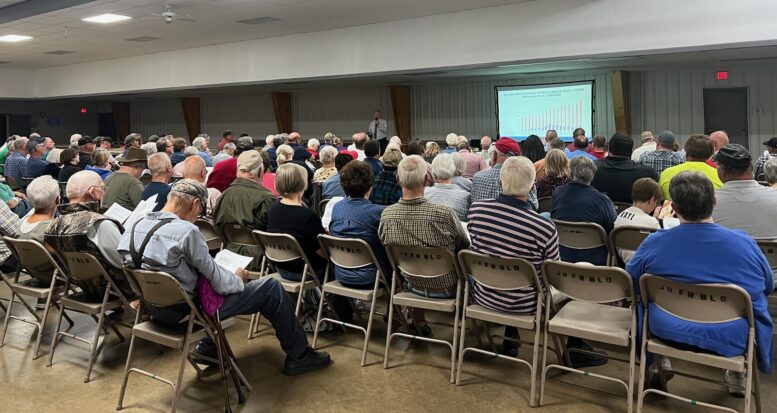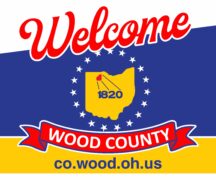By JULIE CARLE
BG Independent News
Higher crop yields and prices contributed to a whopping 77% increase in agricultural land values in Wood County’s recent land revaluation. During a Wednesday night meeting with hundreds of farmers and landowners, Wood County Auditor Matt Oestreich set out to assure them that their property taxes will not go up by 77%.
Instead of using market value to determine property taxes, farmland is valued on current use, thanks to the Current Agricultural Use Value (CAUV) program. CAUV is the provision of Ohio law enacted in 1973 that substantially lowers tax bills for working farmers.
Though the actual amount of the tax increase won’t be known until mid-December, Oestreich wanted to explain the state-directed process for making changes in agricultural land values to the people most affected.
All land values—agricultural, commercial, industrial and residential—increased in the update, which happens every three years, but the ag land increased the most. The increase is a direct result of higher production and crop prices, which are the main factors that are used to establish the CAUV, said Brian Jones, the auditor’s deputy assistant.
“We don’t control how Ohio calculates the CAUV; it’s something the state of Ohio assigns. They give us a new value every three years that coincides with our reappraisal or our triannual update,” Jones said.
The last time Wood County updated its land values was in 2020. The next time will be in 2026, which means these values will be unchanged for the 2023, 2024 and 2025 tax years.
When asked where Wood County currently ranks in agricultural property taxes, Jones said because the county is among the third of the state counties that revalued property this year, it is among the highest. But as the other two-thirds of the state go through updates the next two years, in 2025 Wood County will be among the lowest. “It all averages out over the three years,” he said.
The value of Hoytville soil property—which is found on approximately two-thirds of the farmland in the county—went from $1,970 per acre in 2020 to $3,490 in the most recent update, accounting for Wood County’s 77% increase in agricultural property values.
“There’s probably not a person here who doesn’t have Hoytville,” he said.
Jones took time to break down the state CAUV formula that dictates the agricultural property values across the state.
In addition to income factors of crop yields and prices and cropping patterns, the state formula includes expense factors of non-land production costs and a capitalization rate for net income, he explained.
The formula includes gross operating income—crop yield times crop prices; net operating income—the gross operating income minus non-land production costs; and the value, which takes the net operating income divided by a set capitalization rate.
For crop yields, the 1984 state yield information is used as the basis for determining rates for every soil type in the state. For corn, the bushels-per-acre basis is 118, soybeans is 36.5 and for wheat it is 44.
Using the yield averages from the most recent 10 years (2013-2023), a multiplication factor is applied to the 1984 yield to establish the percentage increase in yields, which for corn was 47% (174 bushels), almost 45% (52.9 bushels) for soybeans and 66% (73.1 bushels) for wheat.
Crop prices, the second factor in the formula, uses a seven-year state average but throws out the highest and lowest years, Jones said. The results for 2023 saw an increase in prices for corn of almost 16%, for soybean a 12% bump up and for wheat an increase of almost 7.5%
The average number of acres farmed across the state each year over a five-year period accounts for the cropping pattern in the formula. For 2023, those numbers were 37.2% for corn, 57% for soybeans and 6% for wheat.
Ohio State University Extension provides information about production costs for the state, using cost data from 2017 through 2023, again, taking out the high and low years and averaging the five years of cost figures, Jones said. Among the cost factors are seeds, fertilizer, chemicals, fuel, repairs, crop insurance, drying, hauling, interest on operating capital, labor, machinery and equipment and miscellaneous.
The information does not include an hourly rate for farmers, which one person suggested, “If you paid them what they are worth then the cost would be higher, and the taxes would be lower.”
Costs for producing an acre of corn came in at $509.17 per acre, an increase of about $6 per acre from 2020. Costs to produce soybeans and wheat reportedly decreased by $8 and $40 an acre, respectively, Jones said.
The math behind the agricultural property values equals the total net operating income of $279.37 divided by the 8% cap rate to arrive at $3,492, rounded to $3,490.
Despite the increase in agricultural property values, the CAUV savings are substantial, Jones said. The final 2023 tax rates will be determined according to tax districts, but he shared that in 2022, CAUV saved Wood County farmers $12 million compared to being taxed on their property’s market value.
He provided a Perrysburg Township farmland example: the market value of their land was valued at $7,100 per acre with a market tax per acre of $183. The agricultural value of Hoytville soil was $1,970 with a CAUV tax per acre of $51, saving the landowner $132 per acre.
Land that is put under conservation has additional savings, he said. “Anyone who has any contracts for conservation with the Farm Services Agency office, instead of paying $40 to $50 an acre are probably paying less than $5 per acre,” he said, reminding them to provide a copy of the contracts to make sure they have the correct conservation acreage identified.
Documentation for the presentation is available on the auditor’s website, but Jones encouraged anyone with questions about their property should contact him at the auditor’s office.
Oestreich reiterated that the taxes will go up, but not the same as the increase of property values.
“What will make a difference is what school district you are in,” he said. Your taxes will go up because the inside millage taxes are going up some. If your school district is on a 20-mil floor, the taxes will go up more. If levies pass this fall, that’s also going to affect your taxes for the next year.”





